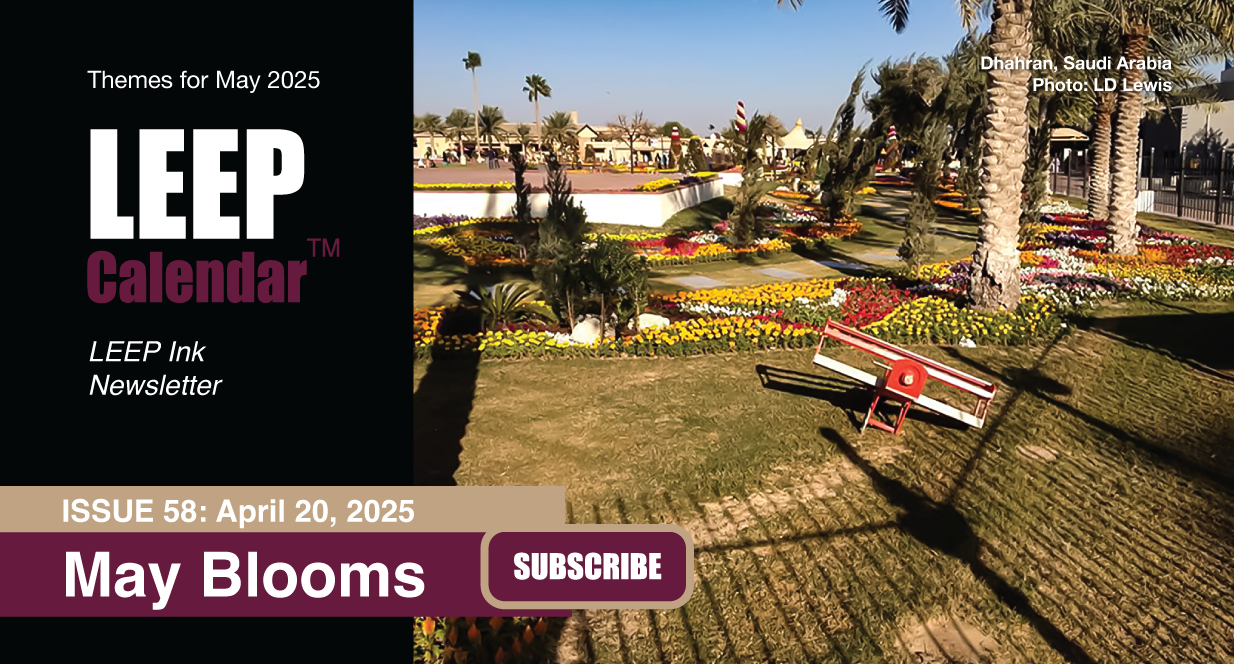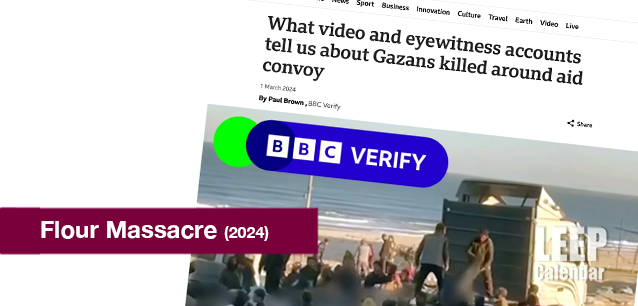 AD
AD
Today is: January 01
Scroll to explore events active on this date.
Additional Events on LEEP
LEEP INK FEATURES

August? Absolutely!
In August, we live through the Dog Days of Summer. It's hot and often humid, and those who can leave for better climates do. Down south, winter is in full force. August is also known as "the ...

In The Heat of July: July 2025 Events
Is it hot enough (or cold enough if you're below the equator) for you yet? There is actually a day for that! Like every month, I pick a diverse collection of events you may or may not know about. This ...

May Blooms: Events in May 2025
Along with October, May is one of the most densely packed months of the year. It's before the summer humidity and the last whole month of the school year. The weather is warming in t...
About the Flour Massacre of 2024
Civil Rights , Legal
Food , Middle East/West Asia
Ends: Feb 29, 2024
DESCRIPTION:
THE 2024 FLOUR MASSACRE
In the early hours of Thursday, 29 February 2024, at least 118 Palestinians were killed during a convoy's attempt to deliver much-needed food aid. In the weeks prior, the United Nations had warned of an impending famine for the approximately 300,000 residents trapped in the north and the 1.9 million in the southern Gaza Strip.
WHY ARE PALESTINIANS TRAPPED?
Since 1967, Israel has exercised complete control of Occupied Palestine. In 2007, Israel completely sealed the area by land, sea, and air as collective punishment for electing Hamas over Israeli-approved politicians. Every item that legally enters the Strip, including water, food, soap, and medical supplies, is monitored down to the allotted calories by the Israeli government. Even essential items like insulin, water-purifying tablets, and chocolate are often prohibited from entering. HOW THE FLOUR MASSACRE UNFOLDED
Named "The Flour Massacre," after the staple delivered, the tragedy unfolded on a coastal roadway just outside the now-razed Gaza City.
To alleviate the man-made humanitarian crisis and prevent starvation, a convoy of approximately 20 trucks, reportedly supported by Israeli, Palestinian, and international businessmen, made its way toward northern Gaza from the Egyptian border, shadowed by the Israeli military on the ground and the air. After passing through an Israel Defense Forces (IDF) checkpoint, the convoy proceeded northward along al-Rashid Street.
As it neared the Nabulsi roundabout on the southwestern fringe of Gaza City, individuals waiting for over a day surged toward it. Upon reaching the trucks, shots rang out in quick succession, and people began to fall. As they realized they were being shot at and killed from the shadows, the panicked crowd attempted to flee. The gunfire intensified, coming from multiple directions. Within minutes, over 100 were dying or dead. In addition to those killed, the Gaza health ministry also confirmed that 760 individuals sustained injuries during the confusion.
CASTING BLAME
The IDF insists the deaths were due to the Palestinians "stampeding," and that its soldiers felt "threatened" by the unarmed civilians attempting to get food. The Israeli military says they only fired "warning shots."
The evidence soundly disputes this. Independent footage from Al Jazeera captures the harrowing moments of gunfire and panic as people scrambled over the aid trucks, seeking refuge. Several eyewitnesses accused Israeli forces of deliberately firing at civilians attempting to access the food aid, a claim corroborated by footage showing bodies being transported away from the scene.
FOCUSING ON FACTS
Hospitals, including al-Awda Hospital, reported receiving hundreds of casualties, nearly 85% with bullet wounds and an additional 15% with injuries consistent with a panicked dispersal of people. The majority of those shots were to the head or heart, meaning the killings were not random.
"Many victims of the massacre suffered injuries from 5.56x45mm NATO bullets; this is a type of bullet fired from Israeli army weapons. A sample of 200 dead and injured victims revealed that they were indeed hit by this type of bullet, and that the bullets were discovered and examined at the massacre site along with shrapnel found in the bodies of the wounded and dead." —Euro-Med Monitor.
Al Jazeera, The Intercept, BBC Verify, and several other media organizations meticulously examined available information, including social media footage, satellite images, and the edited drone videos from the IDF, to construct a coherent account of the unfolding situation.
Predictably, the IDF issued a series of dehumanizing statements portraying the massacre as an "incident of chaotic scrambling for aid that led to looting and trampling, resulting in numerous injuries." IDF spokespersons and Israeli officials have offered varying excuses for the use of gunfire, casting themselves as victims and emphasizing efforts to disperse the crowd and protect the convoy. The evidence from eyewitness testimony, footage, official causes of death, and treated injuries do not support Israel's assertions.
The IDF has pledged to release the complete footage of the incident, which has become a subject of intense scrutiny. Historically, if the victims are Palestinians, Israeli authorities rarely uphold their pledges. THIS GENERATION'S DIER YASSIN
The Flour Massacre of February 2024 is quickly becoming the Dier Yassin Massacre of Israel's latest ethnic cleansing campaign. Dier Yassin, on 9 April 1948, is one of over 50 documented massacres perpetrated by then-self-described Zionist terrorists. Many of these people became the Israeli military following 15 May 1948, and several went on to lead the country. Like Dier Yassin, the Flour Massacre is not an isolated incident. Like Dier Yassin, the Flour Massacre is known and serves as a warning to Palestinians.
After obfuscating the circumstances and attempting to spin the coverage of the Flour Massacre for twenty-four hours, Israel began killing more starving civilians, including children, trying to reach aid again—and again—and again, targeting additional aid convoys. Before the Flour Massacre, Israeli snipers regularly picked off men, women, and children seeking food, often killing whole families at once. They also killed security and NGO personnel delivering assistance in the weeks prior.
ISRAELIS SUPPORT THE ETHNIC CLEANSING
As of 10 March 2024, Israeli polls report that 75% of Israel's Jewish residents overwhelmingly support a ground invasion into Rafah and the continued starvation, murder, and ethnic cleansing of the 2.2 million men, women, and children trapped in the Gaza Strip. What does Israel's 20% non-Jewish population think? They are not permitted to voice an opinion on the genocide. A simple "like" on a social media post often results in arrest and indefinite imprisonment without charge, regardless of age.
Only one country in the world continues to support Israel's unfolding genocide unconditionally: the United States. The rest of the world has called for a permanent ceasefire.
____________________
CONTEXT ON THE CONFLICTRAFAH, GAZA, AND THE PALESTINIANS
Before 7 October, Rafah's population was roughly 200,000. As of that writing, it has swelled to 1.5 million, nearly all displaced.
Rafah, known as Rafia during the Iron Age when the region was called Canaan, had been a thriving center of commerce and trade since at least 3200 BCE, but likely much longer given the ancient populations of Byblos, Damascus, and other regional cities.
Located in the southern part of the Gaza Strip, Rafah is part of the region of Palestine and has been controlled and occupied by the state of Israel since June 1967. Before the establishment of the state of Israel in 1948, the city and region were a vibrant trading hub and a prosperous center of agriculture, textiles, and tourism.
Gaza's native people are Palestinians who have lived in the region for over 6000 years. Their ancestors spoke various languages and were "settled people" or Harari/Fellaheen (as opposed to the Bedouin, who travel from place to place throughout the year). The term "Arab" references a language and cultural group, though the word is often misinterpreted as a race. Harari, Fellaheen, and Bedouin are all Arab peoples. Palestinian denotes a regional location for a distinct group. The collective term "Palestinians" includes original followers of the faiths of Judaism, Islam, and Christianity.
RAFAH AND REFUGEES
Between 1 December 1947 and 31 December 1949, Israel expanded the land given to it by the United Nations by nearly 300% through the ethnic cleansing of the Palestinian people from their homes; many fled to Gaza for safety, believing they could return to their homes once Israel had finished. Israel began its ethnic cleansing before it became a state.
The surrounding Arab armies did come to the defense of the Palestinians, but only after 15 May 1948. These armies also refused to cross into the land granted to the new state by the United Nations. The 1948-49 war was fought on the additional lands Israel had conquered, land the United Nations had allocated to the Palestinians.
HOW PALESTINIANS BECAME REFUGEES
Being refugees for a bit was considered an inconvenience to the Palestinians, but it wasn't as if their land had never been conquered before. When the war ended, the Palestinians thought they would go home, and life would go on with a Jewish flavor rather than Muslim or Christian. This is what survivors will tell you they believed as Israel waged its war to expand its allocated territory. They fled to safety during a war and planned to return when it ended.
Instead, Israel killed those attempting to return, destroyed their homes and businesses, or gave them to new Jewish refugees and immigrants arriving from around the world. To further prevent Palestinians from returning home, the Israelis planted pine forests and built communal kibbutz over razed Palestinian villages, funded by international charity drives. Many a well-meaning person around the world purchased a tree in Israel, thinking it was a benevolent act. In reality, their trees hid war crimes and served to solidify an occupation.
Nealy all evicted Palestinians received zero compensation for their homes, businesses, or property. Instead, they became refugees in Gaza and the neighboring countries.WHEN DID PALESTINE COME INTO EXISTENCE?
"Palestine" is the anglicized version of the Latin "Philistine," in Hebrew "Philistia" (mentioned over 250 times in The Bible), and ancient Egyptian "Peleset." Regardless of pronunciation, the region has existed for at least 3176 years (archeological remains prove this).
The first written reference to "Palestine" traces to ancient Egypt during the reign of Ramses III (1184-1153 BCE), specifically around 1152 BCE, as documented in the Papyrus Harris I, also known as the Great Harris Papyrus. This artifact, containing 1,500 lines of hieroglyphic text, was discovered near Medinet Habu on the Nile, close to Luxor.
PELESET, PHILISTINE, PALESTINE
The hieroglyphs referenced a people known as the PLST (pronounced 'peleset'), indicating early mentions of Palestinians. One notable passage from the papyrus stated, "I extended all the boundaries of Egypt; I overthrew those who invaded them from their lands. I slew the Denyen in their isles, the Thekel and the Peleset (Pwr-s-ty) were made ashes."
Another reference to the Peleset appeared in the Mortuary Temple of Ramesses III at Medinet Habu, dated around 1150 BCE. This text again highlighted the Peleset as adversaries of Ramesses III.
Additionally, the Merneptah Stele, an inscription from Pharaoh Merneptah (1213–1203 BCE), mentioned the Canaanites and the tribe of Israel in the context of a military campaign in Canaan, predating the earliest biblical records of the Kingdom of Saul/Israel around 1020 BCE.
Assyrian texts around 800 BCE referred to the region as Palashtu or Pilistu. By the 5th century BCE, the Greek historian Herodotus, in his work "The Histories," had identified "Palaistine" as encompassing the Judaean mountains and the Jordan Rift Valley within the fifth Persian satrapy, further solidifying Palestine's historical presence in ancient records.
CONQUERED MANY TIMES—NEVER EVICTED UNTIL 1948
Palestine's historical lineage began in the ancient texts created under Egypt's Ramses III's reign.
In 597 BCE, Babylon conquered Palestine. Next, in 538 BCE, the Persians took over, followed by the Seleucids, then the Romans, then the Muslim Caliphate, The Crusaders for a short time, who fell to the Ayyubid Sultanate, then the Mamluk Sultanate, and finally the Ottoman Empire, which ruled Palestine from 1516-1917. This was followed by the British Mandate period, which ended in the violent creation of the nation-state of Israel and the Nakba—the ethnic cleansing of Palestinians from their land.
Israel prevented non-Jewish Palestinians from returning when the war ended, in direct contradiction to the assurances the Zionist leaders had made to the United Nations as a condition of their statehood.
In the two years attributed to the creation of the state of Israel, approximately 17,000 Palestinians were murdered and 750,000 displaced. The 2023-2024 genocide has already killed 150% of that number and displaced 250% more people in five months.
A RHETORICAL QUESTION
For thousands of years, the people of Palestine, who share many faiths, including Judaism, Islam, and Christianity, lived in relative peace under their various conquerors. "Muslim terrorists" didn't threaten previous conquerors, nor did they exist. Only in the past 105 years did this become a problem. Only in the past 105 years has a conqueror tried to remove the people from the land and take it for themselves without compensation and through brutal force.
The region was a haven of cross-cultural trade and cohesiveness for 6000+ years, beginning with Canaan through multiple occupations and rulers. Suddenly, it is not, begging the question: Is it the people or policies?
Sources:
Many thanks to Tanya Cariina Newbury-Smith, PhD at Exeter University's Institute for Arab and Islamic Studies for providing the background and history of Rafah and Palestine.
Additional resources consulted:
The Concept of Palestine: A Four Thousand-Year History (2018), by Nur Masalha
The Invention of Ancient Israel: The Silencing of Palestinian History (1997) by Keith W. Whitelam
What video and eyewitness accounts tell us about Gazans killed around aid convoy, 1 March 2024, by By Paul Brown, BBC Verify. https://www.bbc.com/news/world-middle-east-68445973
The Ethnic Cleansing of Palestine (2006) by Ilan Pappé.
The Great War for Civilisations: The Conquest of the Middle East, (2005) by Robert Fisk.
New evidence confirms Israel's full involvement in 'Flour Massacre' of starving Palestinian civilians (6 March 2024), Euro-Med Human Rights Monitor.
And cumulative information over the years from:
Al Jazeera
Ha'artez
The Intercept
Mondoweiss
Democracy Now
The Gray Zone
Breaking Points
The Electronic Intifada
Judging Freedom
Jonathan Cook
The New York Times
The Guardian
The Majority Report
Middle East Eye
Washington Report on Middle Eastern Affairs
Foreign Policy Magazine
...and many other films, books, symposiums, lectures, thesis, and memoirs.
VIDEOS
ADDITIONAL IMAGES
Currently, this event does not have supporting images.
Where would you like to go now?
 AD
AD



/footer-logo.svg)
